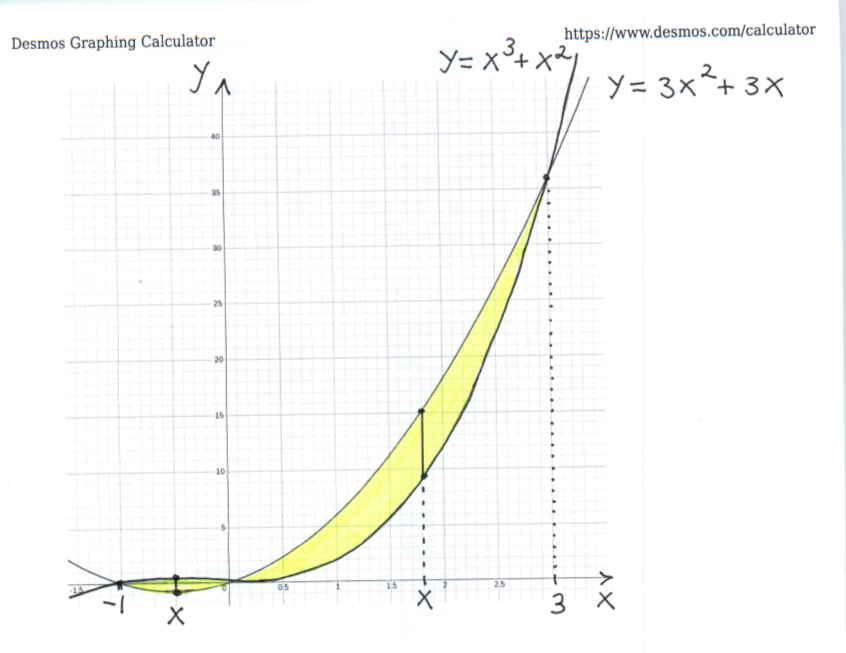SOLUTION 5: Compute the area of the
region enclosed by the graphs of the equations $ y=x^3+x^2 $ and $
y=3x^2+3x $ . Begin by finding the points of intersection of the
two graphs. From $ y=x^3+x^2 $ and $ y=3x^2+3x $ we get that
$$ x^{3} + x^{2} = 3x^{2} + 3x \ \ \longrightarrow $$
$$ x^{3} - 2x^{2} - 3x = 0 \ \ \longrightarrow $$
$$ x(x^{2} - 2x - 3) = 0 \ \ \longrightarrow $$
$$ x(x-3)(x+1) = 0 \ \ \longrightarrow \ \ x=0, x=3, \ or \ x=-1 $$
Now see the given graph of the enclosed region.

Using vertical cross-sections to describe this region, which is made up of two smaller regions, we get that
$$ -1 \le x \le 0 \ \ and \ \ 3x^{2} + 3x \le y \le x^{3} + x^{2} $$
in addition to
$$ 0 \le x \le 3 \ \ and \ \ x^{3} + x^{2} \le y \le 3x^{2} + 3x ,$$
so that the area of this region is
$$ AREA = \displaystyle{ \int_{-1}^{0} (Top \ - \ Bottom) \ dx +
\int_{0}^{3} (Top \ - \ Bottom) \ dx } $$
$$ = \displaystyle { \int_{-1}^{0} ((x^{3}+x^{2})-(3x^{2}+3x)) \ dx
+ \int_{0}^{3} ((3x^{2}+3x) -(x^{3}+x^{2})) \ dx } $$
$$ = \displaystyle { \int_{-1}^{0} (x^{3}-2x^{2}-3x) \ dx +
\int_{0}^{3} (-x^{3}+2x^{2}+3x) \ dx } $$
$$ = \displaystyle { \Big( \frac{x^{4}}{4} - \frac{2x^{3}}{3} -
\frac{3x^{2}}{2} \Big) \Big\vert_{-1}^{0} + \Big( -\frac{x^{4}}{4}
+ \frac{2x^{3}}{3} + \frac{3x^{2}}{2} \Big) \Big\vert_{0}^{3}} $$
$$ = \displaystyle { \Big( \frac{0^{4}}{4} - \frac{2(0)^{3}}{3} -
\frac{3(0)^{2}}{2} \Big) - \Big( \frac{(-1)^{4}}{4} -
\frac{2(-1)^{3}}{3} - \frac{3(-1)^{2}}{2} \Big) + \Big(
-\frac{3^{4}}{4} + \frac{2(3)^{3}}{3} + \frac{3(3)^{2}}{2} \Big) } $$
$$ \displaystyle { \ \ \ \ - \Big( -\frac{0^{4}}{4} +
\frac{2(0)^{3}}{3} + \frac{3(0)^{2}}{2} \Big) } $$
$$ = \displaystyle { \Big( 0 \Big) - \Big( \frac{1}{4} +
\frac{2}{3} - \frac{3}{2} \Big) + \Big( -\frac{81}{4} + 18 +
\frac{27}{2} \Big) - \Big( 0 \Big) } $$
$$ = \displaystyle { - \Big( \frac{3}{12} + \frac{8}{12} -
\frac{18}{12} \Big) + \Big( -\frac{81}{4} + \frac{72}{4} +
\frac{54}{4} \Big) } $$
$$ = \displaystyle { - \Big( -\frac{7}{12} \Big) + \Big(
\frac{45}{4} \Big) } $$
$$ = \displaystyle { \frac{7}{12} + \frac{45}{4} } $$
$$ = \displaystyle { \frac{7}{12} + \frac{135}{12} } $$
$$ = \displaystyle { \frac{142}{12} } $$
$$ = \displaystyle { \frac{71}{6} } $$
Click HERE to return to the list of problems.

